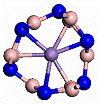Department of Physics and Astronomy: Publications and Other Research

Stephen Ducharme Publications
Document Type
Article
Date of this Version
6-2010
Abstract
We report electrical characterization of memory elements consisting of a p-type silicon field-effect transistor incorporating a ferroelectric polymer Langmuir–Blodgett film into the gate insulator to produce bistability through polarization hysteresis. The thin gate insulator, consisting of a 10 nm thick silicon oxide layer and a 35 nm thick ferroelectric polymer film, enabled bistable operation at 4 V. Device hysteresis as a function of gate voltage was evident both in the device capacitance, which was measured between the gate and drain, and in the source-drain conductance. The ferroelectric film polarization was not saturated, even up to operating voltages of 10 V. This is likely the reason for the short state retention of less than 10 s at room temperature. The hysteresis vanished as the sample was heated toward the ferroelectric-paraelectric phase transition temperature, showing that the bistability was due to ferroelectric polarization reversal.


Comments
Published in JOURNAL OF APPLIED PHYSICS 107, 124119 (2010); doi:10.1063/1.3437638 © 2010 American Institute of Physics. Used by permission.